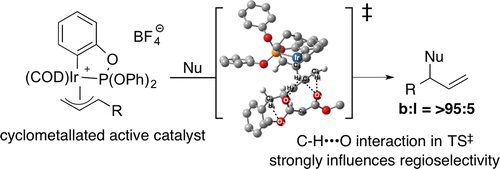Origins of Regioselectivity in Iridium Catalyzed Allylic Substitution

Detailed studies on the origin of the regioselectivity for formation of branched products over linear products have been conducted with complexes containing the achiral triphenylphosphite ligand. The combination of iridium and P(OPh)3 was the first catalytic system shown to give high regioselectivity for the branched product with iridium and among the most selective for forming branched products among any combination of metal and ligand. We have shown the active catalyst to be generated from [Ir(COD)Cl]2 and P(OPh)3 by cyclometalation of the phenyl group on the ligand and have shown such species to be the resting state of the catalyst. A series of allyliridium complexes ligated by the resulting P,C ligand have been generated and shown to be competent intermediates in the catalytic system. We have assessed the potential impact of charge, metal–iridium bond length, and stability of terminal vs internal alkenes generated by attack at the branched and terminal positions of the allyl ligand, respectively. These factors do not distinguish the regioselectivity for attack on allyliridium complexes from that for attack on allylpalladium complexes. Instead, detailed computational studies suggest that a series of weak, attractive, noncovalent interactions, including interactions of H-bond acceptors with a vinyl C—H bond of the alkene ligand, favor formation of the branched product with the iridium catalyst. This conclusion underscores the importance of considering attractive interactions, as well as repulsive steric interactions, when seeking to rationalize selectivities.
Read more on publisher's site.